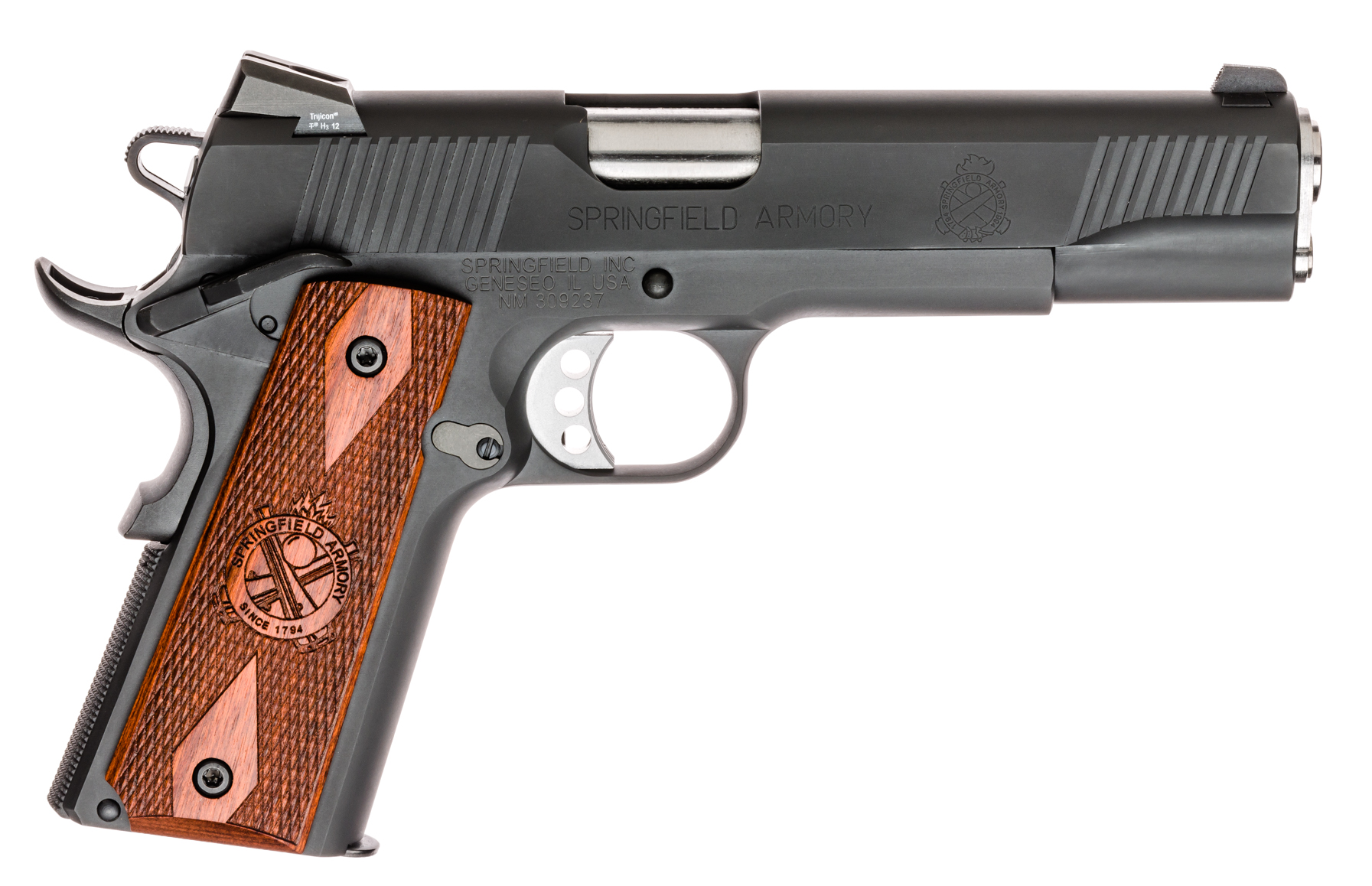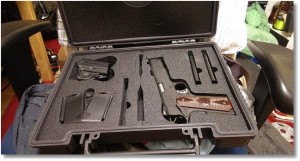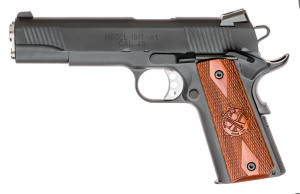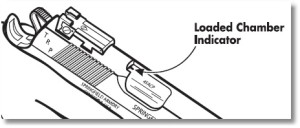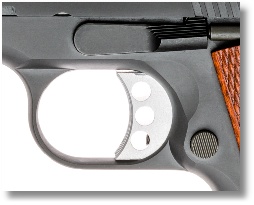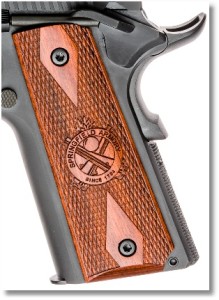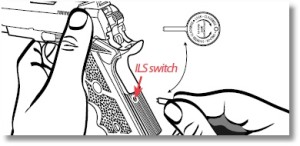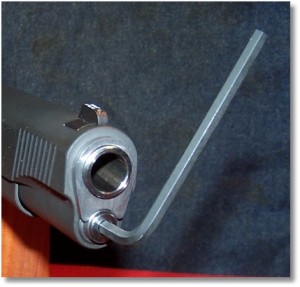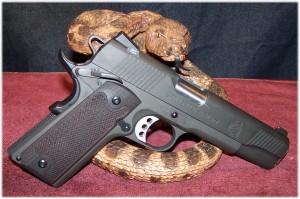There is the Springfield 1911 and there is the Springfield 1911 Loaded. Other categories are, of course, available to include the following:
- 1911 EMP® Model (9MM and 40SW)
- 1911 Champion™ Operator Lightweight Model (.45ACP)
- 1911 Mil-Spec Model (.45ACP)
- 1911 Range Officer® Compact Model (9mm and .45ACP)
- 1911 Range Officer® Model (9MM and .45ACP)
- 1911 Range Officer® Champion™ Model (9MM and .45ACP)
- 1911 Loaded Model (.45ACP)
- 1911 TRP™ Model (.45 ACP)
Within the “Loaded” category, there are five models to choose from:
- Marine Corp Operator (R*)
- LB Operator (R*)
- Lightweight Operator (R*)
- Parkerized
- Stainless Steel
R* designates a model with rails.
The Parkerized model (Model PX1909LP), is what is under review at this time and the specifications out listed below.
WHAT’S IN THE BOX?
Springfield Armory, as their usual, tries to provide the customer with an array of accessories to get the shooter started when using their products. The Springfield 1911 Loaded came in a polymer, lockable carrying/storage case complete with carrying handle and double cannon logo. Compartmentalized within the case is a OWB holster and double magazine pouch, bore cleaning brush, slots for spare magazines, and a plastic bag of tools that you will need to secure the firearm and also to field strip and reassemble the firearm. The top side of the case utilizes a removable partition that separates a Operation and Safety Manual, a Springfield product card, and a 1911 Loaded Coupon from which you can order Springfield products at a reduced price.
The holster is of polymer material and is of the paddle holster type. It also incorporates an adjustment screw (5/32-inch hex=head screw) for proper firearm fit in the holster. The double-magazine carrier, also made of polymer, is a belt loop affair that secures two spare magazines at angles for easy retrieval. The holster and magazine carrier would be fine at the range but not something I would consider for concealment – but it will get you started. The bore brush is a nice touch, but I would replace the brush with a bore snake if I were to actually carry the case to the range.
GETTING TO THE MEAT OF THE MATTER:
After recently completing a training course with the Ruger SR1911CMD-A, I realized that a different 1911 carry was in order. While the Ruger SR1911CMD-A performed admirably (two failures were my fault; a failure to feed due to limp-wristing while firing one-handed, and neglecting to drop the thumb safety at one time – I was tired, alright!). The “Commander” length barrel is an optimum carry length (IMHO) and the lightweight of the Ruger SR1911CMD-A made it a pleasure to carry and operate. But, I needed a couple of things on a carry 1911-based pistol that the Ruger SR1911CMD-A did not provide and a search began for a new 1911 carry.
After the training course was completed and I returned home, I switched out the Ruger SR1911CMD-A for a Rock Island 1911 FS Tactical for a week and finally decided that it better suited my needs; it was going back in time when I used to carry a Colt Series 80 MKIV Government Model 1911. Although the features that I wanted (I’ll get to them in a bit) are on the Rock Island 1911 FS Tactical, I wanted a little more quality in a 1911 carry pistol. I have had to tweak the Rock Island 1911 FS Tactical a bit and I don’t mind guns that I have had to tweak for my personal defense, as it is sometimes necessary with a 1911 pistol to ensure that everything runs according to Hoyle.
I did not have a lot of money to spend on another 1911-based pistol so I was looking for the best deal that I could find. A search of the WWW helped me narrow down the choices to two pistols in my price range; the Remington R1 Enhanced and the Springfield Armory 1911 Loaded – both in stainless steel, which I prefer for carry, but I am always open to options.
I spent a week pondering until I was weak and weary. I finally accepted the fact that there was going to be another 1911-based pistol and began the journey to my local gun shop where they have catered to my wants on several occasion. I stopped in to talk to my Son-In-Law beforehand with hope that he would talk me out of such a thing. He was not forceful enough. The journey continued.
It is actually amazing to see how many 1911-based pistols are at this shop. Some well beyond my fiscal reach and many within it. That is scary but satisfying at the same time. They had one Remington R1 Enhanced. It had a barrel on which I could attach a suppressor, which was quickly rejected. They had some 1911 pistols that had rails; I detest rails on a 1911-based pistol – it is simply un-American and ruins the sculptured lines of the pistol. Totally unacceptable! They had a TALON Ruger SR1911CMD-A that was really nice, but I have a Ruger SR1911CMD-A that is really nice. The Remington R1 Enhanced also had target sights. It was put back in the case along with a Kimber or two and a Dan Wesson 1911.
Finally, the salesperson pulled out the Springfield 1911 Loaded. I was disappointed that it was not stainless steel, but otherwise had all of the features that I was looking for. After performing a safety check, a visual inspection was made, the trigger pulled and I actually liked what I saw and felt. I decided to take a chance on it. So, let’s get to the meat of the matter.
The Springfield 1911 Loaded is a full-size fighting pistol that weighs in at about 40 ounces. I wanted the weight to help in recoil management. I know, everybody says to go light for carry. With anything above 9mm, I feel that extra weight is worth it when you are trying to push a 230-grain JHP round out the barrel. The extra weight certainly does not hurt.
The Springfield 1911 Loaded features a two-piece full length guide rod, which I will bark about later, but it does contribute to the weight on the front end of the pistol. Since all pistols shoot better than I do, I can’t comment on an increase in accuracy. In fact, Rob Leatham of Springfield Armory simply says that it helps to keep the recoil spring in line and that the extra weight, he feels, helps with recoil. I’ll have to take his word on that.
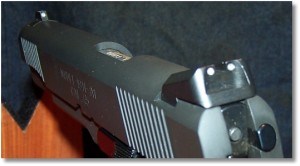
Low-profile NOVAK 3-dot Tritium Night Sights are Standard. They glow green in low and no light conditions
On this particular model NOVAK-style, low-profile Tijicon night sights are standard and I do appreciate them; albeit, they are small but do pop out in low light conditions.
The ejection port is lowered and flared, which helps to quickly get rid of expended brass that is pushed out by the robust, frame-mounted ejector.
The slide and frame are of Parkerized forged carbon steel while the 5-inch match-grade barrel and bushing are stainless steel, as is the 2-piece full length guide rod and guide rod bushing. The contrast on the front end looks nice against the finish of the pistol. The slide has forward, slanted serrations that are quite robust and provide a secure grip. The serrations at the rear of the slide are greater in number than those up front but still provide a good purchase for the hand.
The barrel’s chamber, like the Ruger pistols, has a “look see’ port at the rear to assist in determining if the pistol is loaded at a glance, which is good because you cannot perform a press check with this pistol due to the 2-piece full length guide rod. As far as I am concerned, the pistol is always loaded unless the slide is to the rear. But, that’s just me.
The skeletonized trigger is a long, aluminum type with over-travel adjustment provided by a set screw within the trigger assembly itself. The face of the trigger is serrated and flat with a slight bevel at the edges. Trigger over-travel, out of the box, is virtually non-existent. The new trigger’s pull, out of the box is just shy of 5-pounds with very little take-up and a very crisp break. I’m sure that the trigger will smooth out after some use and a five-pound trigger for defensive use is fine with me. I am not one who likes surprise trigger breaks. With the Springfield 1911 Loaded, I know that once the slack is taken up, and the trigger wall is met, just a little pressure from there will drop the hammer. Trigger reset is also very short.
The grip panels are Cross Cannon™ Double Diamond Cocobolo and provide a good hold on the pistol with the provided checkering. The grip panels are relatively thick and fit well in my hand. I do have a set of LOK grip panels ordered for the Rock Island 1911 FS Tactical and they may find their way on the Springfield 1911 Loaded, but that’s yet to be decided. The grip panels are held in place by hex-head screws. The grip panels are fine as they are, but with a pistol of this size and weight, some extra grip texturing would not hurt (see, UPDATE 01/10/2016).
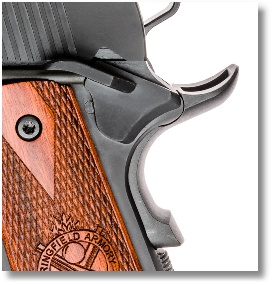
Well-Swept Beaver-tail Grip Safety Adds Comfort and Control. Note Memory bump for Positive Engagement
The front strap is plain while the mainspring housing is made of finely-checkered polymer that blends into an excellent beaver-tail grip safety, which helps to get the hand high on the pistol as possible while protecting the hand from slide (or hammer) bite. The beaver tail also helps to position the hand on the grip during the draw stroke. A memory bump on the beaver tail helps for a full pressing of the grip safety when gripping the pistol. A skeletonized, serrated and roiled hammer assists in cocking the piece and lowering the hammer. A well-sprung hammer is evident. Slide-to-frame fit is excellent and, true to the 1911, a robust, well-tensioned internal extractor helps to pull those healthy-sized .45 ACP expended shells from the chamber.
Internal finishing is excellent and the Springfield 1911 Loaded reveals its Series 70 heritage by not having a hammer-block safety. However, there are safeties. There is a safety stop on the hammer. The Safety Stop is a flat, shelf like surface of the hammer that functions automatically. It will engage the sear in the unlikely event of primary sear notch failure. This will prevent the hammer from falling fully forward unintentionally and will ensure against uncontrolled automatic file. It also prevent the hammer from striking the firing pin should your hand slip from the slide or hammer while cocking the pistol provided the hammer is rotated past the safety stop. It is located such that when the sear engages the Safety Stop, the sear can be disengaged by squeezing the trigger. It falls because the sear slides over the flat part of the Safety Stop to release the hammer. This is intentional but will not allow the pistol to fire. It will not fire because the hammer is almost forward when it is released from the sear. The Safety Stop is not a manual safety and should not be engaged by hand. Do not carry the firearm while Safety Stop is engaged.
The Springfield 1911 Loaded also incorporates an ILS (Integrated Locking System) on the rear of the mainspring housing. The ILS is locked and unlocked by a special key, which means that you do not want to lose the special key after you have locked the gun with the ILS. There is also a tool for removing the mainspring housing with the ILS (another tool that you should not lose). The Operation and Safety Manual has full instructions for removal, disassembly, and assembly of the mainspring housing, and this is one time that I will say please read the manual.
The slide lock is the usual fair to be found on a 1911-based pistol and now we get to the second reason that I wanted the Springfield 1911 Loaded – the ambidextrous thumb safety. The slide lock on this particular model was not Parkerized as is the rest of the pistol and stands out like a sore thumb. It is; however, like the ambidextrous thumb safety, serrated and provides a good gripping surface – and you will need it at first. Due to the heavy recoil spring, the slide lock takes a healthy effort to release the slide when new.
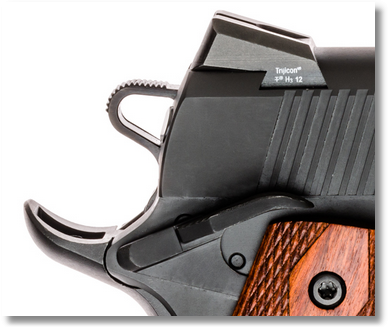 1911 purist really don’t like the ambidextrous thumb safety, and I was one of them – until after a recent training course. What the training course revealed to me was that I probably need a pistol with an ambidextrous thumb safety. That revelation did not occur to me during the course but at a later thinking session. Some of the drills that were performed in the course would have been better performed left-handed. The standard 1911-based pistol, of course, has a left-side thumb safety lever. While it can be operated with the trigger finger of the left hand, it is highly awkward to do so and the possibility of losing the grip on the firearm is high. While there are methods of placing the safety off with the right hand, it is far much faster (and safer) to simply push the thumb up or down on the right side of the pistol with the thumb of the left shooting hand. You may also find yourself transferring the pistol from one hand to the other. Doing so with the thumb safety on is the safest course to follow. The ambidextrous thumb safety on the Springfield 1911 Loaded is not only ambidextrous but is also extended, which makes getting a purchase on the thumb safety a whole lot easier than with a standard thumb safety. However, new and out of the box, the thumb safety is stiff and I was using both thumbs to push the safety up to the safe position. That, I am sure will go away as the pistol breaks in.
1911 purist really don’t like the ambidextrous thumb safety, and I was one of them – until after a recent training course. What the training course revealed to me was that I probably need a pistol with an ambidextrous thumb safety. That revelation did not occur to me during the course but at a later thinking session. Some of the drills that were performed in the course would have been better performed left-handed. The standard 1911-based pistol, of course, has a left-side thumb safety lever. While it can be operated with the trigger finger of the left hand, it is highly awkward to do so and the possibility of losing the grip on the firearm is high. While there are methods of placing the safety off with the right hand, it is far much faster (and safer) to simply push the thumb up or down on the right side of the pistol with the thumb of the left shooting hand. You may also find yourself transferring the pistol from one hand to the other. Doing so with the thumb safety on is the safest course to follow. The ambidextrous thumb safety on the Springfield 1911 Loaded is not only ambidextrous but is also extended, which makes getting a purchase on the thumb safety a whole lot easier than with a standard thumb safety. However, new and out of the box, the thumb safety is stiff and I was using both thumbs to push the safety up to the safe position. That, I am sure will go away as the pistol breaks in.
Whoops, I almost forgot the magazine release button. If you have a long thumb, you will have no problem pushing the magazine release button on the left side just behind the trigger guard. There is no relief cut-out on the grips and the magazine release button is not extended. The magazine release button is a little stiff when new but releasing a magazine is very doable. When running the pistol left-handed, I had to use an old family recipe for pushing the magazine button. This entails rotating the support hand (right hand) under the shooting hand with the thumb of the fight hand on the side of the trigger guard and the forefinger on the magazine release button. Push in with the forefinger and out pops the magazine. I’m sure (and I hope) that after the pistol wears in that I will be able to use the trigger finger of the shooting hand to drop the magazine (time will tell).
The Springfield 1911 Loaded comes with two 7-round, flush-fit magazines of unknown origin. Concealed carriers might stick with the flush-fit magazine for carry and opt for 8-round spare magazines. Because of my holster cant, I can conceal an 8-round magazine with “bump pad” in the pistol just fine and that is what I opt for and Wilson Combat magazines fit, operate, and eject just dandy, thank you.
Now, let’s get into the 2-piece, full-length guide rod thing.

Guide Rod is a 2-Piece, full-length Unit. The Pistol Cannot Be Disassembled and Put Back Together Without Tools.
Unlike conventional 1911-based pistol disassembly and assembly, as well as some 1911-based pistols that have one-piece full length guide rods, the Springfield 1911 Loaded takes tools, which are provided with the pistol but; nonetheless, tools are required.
After ensuring that the pistol is safe, a 5/32-inch hex wrench is used on the front of the guide rod to separate the guide rod halves. The first time that I tried this, I feared that I was going to break or strip something because I could not get the front half of the guide rod loose. It finally took the help of a plastic-faced hammer to break it loose. Once loose, the front half of the guide rod is unscrewed, removed, and set aside. Next, the guide rod bushing is pressed down enough to swing the barrel bushing to the left. I was able to use a bushing wrench for this while keeping the face well away from the guide rod bushing. Slow and cautious are the words here. Once the guide rod bushing has been removed, the pistol disassembles like any other 1911.
Assembling the pistol is just as much fun. A small screwdriver is needed to press the slide lock retaining pin inward as you push the slide lock into place. Once that is accomplished (you will be using the small screwdriver again), you must press the guide rod bushing just past the point where the barrel bushing can be moved over it enough to keep it from flying out. The small screwdriver is then used to press the guide rod bushing inward enough to lock the barrel bushing into place. I was able to use just my thumb but it required an effort. Finally, and using the 5/32-inch hex-head wrench, the top half of the guide rod is screwed into place just past finger tight. Did I say that I probably would be replacing the 2-piece guide rod with a better one-piece full length guide rod – or even a standard 1911 guide rod and bushing? I believe that it is time to consult my certified and competent gun smith. But, I do have other resources. I’ll talk later on that in “The Aftermath.”
RANGE TIME:
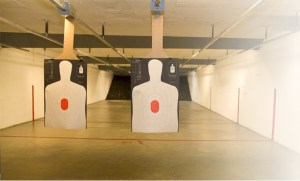 Range time consisted of a basic “where do I need to put the sights” and then performing a few two-handed and one-handed drills while trying to put 230-grain FMJ rounds from Georgia Ammo downrange and on target as best I could. I was not shooting for accuracy, but I was shooting for function. If I felt that I (and the Springfield 1911 Loaded) was accurate in doing so, it is a feather in the cap. I would do more accuracy testing at the next range outing.
Range time consisted of a basic “where do I need to put the sights” and then performing a few two-handed and one-handed drills while trying to put 230-grain FMJ rounds from Georgia Ammo downrange and on target as best I could. I was not shooting for accuracy, but I was shooting for function. If I felt that I (and the Springfield 1911 Loaded) was accurate in doing so, it is a feather in the cap. I would do more accuracy testing at the next range outing.
I ran two magazines of 230-grain ball out the barrel for a function check and everything functioned well.
Next was to run the drill that I mentioned in one of my post at http://guntoters.com/index.php/topic,9384.0.html, but with a change-up in technique. Rather than pulling the pistol into me and swapping hands, the pistol was left extended toward the target and the transition went smoothly and without incident. The Springfield 1911 Loaded was run one handed and two handed. With the target at my usual 10-yards I went to work.
One hundred rounds were sent downrange without fail. The POI is a little high from POA but the necessary correction was made; with 230-grain ammunition the sights were set at the bottom of the center of the bulls-eye’s circle on a standard silhouette target. A six o’clock hold will result in a 3/4-inch POI above the point of aim. The majority of the bullet impacts was just above the center of the bulls-eye and produced a fist sized hole. All other bullet impacts, with noted exceptions, were in the 9-ring (one-handed, left-hand shooting caused some fliers, but that was expected for the first time running this drill with a pistol that I have never shot before.). After the drill was completed, I then emptied two magazines doing the Mozambique drill shooting strong side two-handed – two center mass one to the head. All resulting head shots were within a three-inch circle pretty close to center of the head. Body shots contributed to the fist-size hole just above the bulls-eye.
To put it as plainly as I can, the Springfield 1911 Loaded is a keeper and I have no doubt that I can rely on it. The ambidextrous safety, which was well used during the drill, has loosened ot the point that only one thumb is necessary to operate it, and while the slide lock is still a little stiff, it is wearing in well. The trigger is superb and I knew exactly when the sear was going to release. Even as heavy as this pistol is, when firing one-handed there is still some significant muzzle flip; right-handed is up and left and left-handed is up and right. I have to work on that.
I left the range extremely pleased with the pistol.
THE AFTERMATH:
Upon arriving home, I knew that I had to do two things; one was to see if I had a guide rod assembly that would fit the Springfield 1911 Loaded, and two was to replace the slide lock assembly with a unit that was of the same finish as the pistol, which is Parkerized. Perhaps, Springfield Armory ran out of Parkerized slide lock assemblies when they assembled these pistols, but this one stuck out like a sore thumb and it was a semi-gloss finish. The slide lock worked fine; it was an aesthetic issue with me.
Oh, what to do!
I looked at my Rock Island 1911 FS Tactical, which just happens to have a one-piece full length guide rod and a Parkerized slide lock. I thought why not?
This is the beauty of 1911-based pistols that are built to military standards, interchangeability of parts is a nice thing, and I hoped that the desired parts to put on the Rock Island 1911 FS Tactical would work on the Springfield 1911 Loaded.
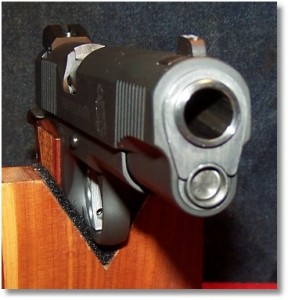
The Springfield Guide Rod and Bushing Were Swapped with that From the Rock Island 1911 FS Tactical – A perfect Fit
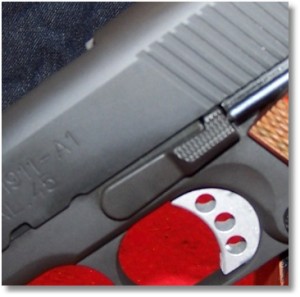
The Slide Lock Assembly, Also from the Rock Island 1911 FS Tactical blends in well with the Springfield’s Parkerized 1911 Loaded Frame
Both pistols were disassembled, the desired Rock Island 1911 FS Tactical parts were test fitted to the Springfield 1911 Loaded and the one-piece full-length guide rod, guide rod bushing, and slide lock assemblies were installed on the Springfield 1911 Loaded. Now, I can disassemble the Springfield 1911 Loaded without tools. Note, in the image, that the full-length guide rod is slightly below the front of the guide rod bushing. This allows me to simply press the guide rod bushing inward so that the barrel bushing can be rotated, which I could not do before with the original two-piece full length guide rod without disassembling the guide rod. All exchanged parts are working in perfect harmony – as it should be. The donor pistols, the Rock Island 1911 FS Tactical, is now fitted with the Springfield two-piece guide rod, guide rod bushing, and slide lock assembly. You don’t think that I was going to waste them did you? They are working just fine on the Rock Island 1911 FS Tactical, thank you. They will be replaced; however, as all I did was move the issue from one pistol to another.
Now, let me say this before you do that – change out the guide rod and guide rod bushing. There is nothing wrong with the Springfield setup as is. It only makes the disassembly and re-assembly more complicated than it needs to be. With that said, and the more I thought about it, it made more sense to me to leave the pistol as is and I returned everything to its original state because the pistol ran just fine out of the starting gate. It goes back to the old saying, “If it ain’t broke, don’t fix it!” With that said, if I have a 1911-based pistol with a full-length guide rod, I will work with it. If the pistol does not have a full-length guide rod, that is fine as well. As long as the pistol does what I need for it to do when I need for it to do it, why should I mess with it. You may have surmised, at this point, that the Springfield 1911 Loaded is back to its original configuration.
UPDATE 01/10/2016:
After firing the first 50-rounds or so, and upon returning back home to clean the pistol, I noticed that the rear of the Recoil Spring Rod (the FLGR, if you will) had peened the base of the Swing Link mount slightly. The Swing Link would not fall all the way forward (not that it does during actual operation) due to this peening action. Rather than sending the pistol back to Springfield Armory, I decided to do some DIY gunsmithing by filing and polishing the peened area. To my satisfaction, the DIY gunsmithing was effective and peening is no more. I may; however, submit the barrel to my trusted gunsmith for a better finishing and polishing job.
In addition, the Springfield 1911 Loaded was fitted with a new set of grip panels from LOK grips. These grips are nicely styled, are mild in texture, and provide a good grip on the pistol. As of yet, the Springfield Armory 1911 Loaded has not been considered for EDC. However, if that decision is made, I will probably outfit it with a set of Hogue Rubber Finger Groove Wraparound Grips (See my review on these grips at: https://guntoters.com/blog/2016/01/08/hogue-wraparound-rubber-grips-with-finger-grooves-1911-colt-45-9mm-c45-000/).
SUMMARY:
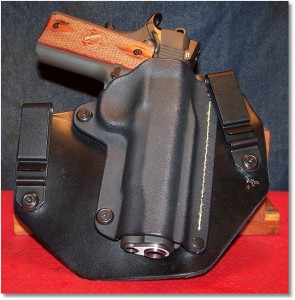
The Springfield 1911 Loaded In the SHTF Gear IWB Holster. Note the “Peek-a-Boo” at the bottom But Everything is Protected
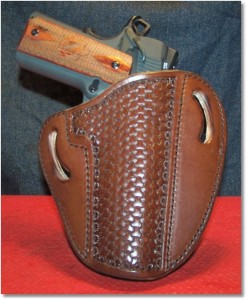
The Springfield 1911 Loaded in an OWB Holster by Leather Creek Holsters of Gainesville, Georgia. I used this holster in a recent training course and it is an excellent holster
At this point I should say that the Springfield 1911 Loaded is the best, most accurate, and highly dependable and reliable 1911-based pistol I have ever shot. I don’t know about all that but it is a pretty darn good shooter, it spits bullets out the muzzle on command, and efficiently rids the pistol of expended shells so that I get to do it over again. Let’s just say that the Springfield 1911 Loaded is the combat version of the Range Officer, which is an exceptional firing handgun.
The Springfield 1911 Loaded has all the features that I was looking for an EDC 1911-based pistol. It is a full-fledged, full-size fighting handgun that can hold its own with more expensive 1911-based pistols. Managing recoil is easy due to the weight of the pistol. Muzzle flip is very little and you gain a little ballistic attitude and better accuracy with the 5” barrel.
Surprisingly, the Springfield 1911 Loaded (PX1909LP) is the same 40-ounce weight (unloaded) as the Stainless Steel version (Model PX9151LP). By comparison; the Remington R1 Enhanced weighs in at 39.5 ounces (unloaded), the Ruger SR1911 tugs at the pants with 39 ounces (unloaded), the Kimber Eclipse II (LG) tops the scales at 38 ounces (unloaded) while topping the scales at $1589 MSRP, and the Rock Ultra FS pops in at 39.84 ounces (unloaded). If you are looking for a compact and lightweight carry piece, the Springfield 1911 Loaded is not for you.
The PX1909LP comes with Low Profile Combat, 3 – Dot Tritium as standard fare; whereas, the (Model PX9151LP) has standard Low Profile Combat, 3 – Dot sights. I’ll take the night sights, thank you.
How well the Parkerized finish on the 1911 Loaded (PX1909LP) holds up is up for grabs; however, Glock uses a Parkerized finish over top of their Tennifer coating on the slides of their pistols. Parkerizing, of course, is commonly used on firearms as a more effective alternative to bluing and replaced bluing on military firearms since around WWII. I will have to say; however, that there is nothing prettier than a highly-polished and blued 1911.
The downsides to the pistols, from my vantage point, are the lack of ease when disassembling and reassembling and the two provided magazines should be placed in the “if everything else fails” box and replaced with quality magazines like Wilson Combat or comparable.
Along with this transaction, I also have taken advantage of the Springfield “Gear Up and Go” promotion offer and will soon be receiving 2 Extra Magazines (not sure of the round count, but I assume 7-round, flush-fit magazines as that’s what came with the pistol), a Ballistic Nylon Dual Pistol Range Bag, and Double Mag Pouch. That, according to Springfield Armory, is $135 worth of goodies.
MSRP (according to Gallery of Guns) is $929 (and is out of stock). I can tell you that I paid a couple of Franklins less for it and even the counterman at the LGS was surprised at the price.
In 1974, the Springfield Armory name was licensed to Robert Reese, to form Springfield Armory, Inc., a company that manufactures semi-automatic versions of the M14 rifle and M1911 pistol. The company is not located in or near Springfield, Massachusetts and has no direct association with the original Springfield Armory. Aside from the weaponry foundation of the company, Springfield Armory, Inc. has produced many fine firearms for us civilians, and not just in 1911-based pistols. The company’s XD, XDm, and XDs striker fired pistols are exceptional choices, and we are thankful for that. And, while I do have other Springfield products, the 1911s have always been one of my favorites – and they rarely disappoint.
Besides, when a full-size 1911-based pistol is pulled from the holster, and the large bore is revealed, people sit up and take notice.
RESOURCES:
- Springfield Armory 1911 Loaded Models: http://www.springfield-armory.com/products/1911-loaded-45-acp/
- SHTF Gear Holsters: http://www.shtfgear.com/
- Leather Creek Holsters: http://www.leathercreekholsters.com/home.html
- 1911 Classics Red Black G10: http://lokgrips.com/gun-grips/1911/classics/classics-red-black-g10/
![]()


